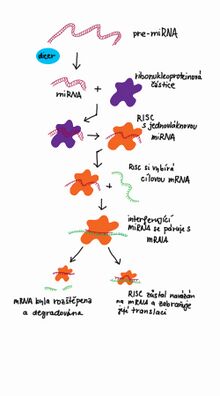miRNA
MicroRNAs (abbreviated miRNAs) are small non-coding molecules RNA. Their size ranges from 21 to 28 nucleotides (most often 22). MiRNAs are completely or partially complementary to one or more mRNAs and their main function is to regulate the expression of these mRNAs and thus their products. The existence of miRNAs was first discovered in 1993 by Lee and colleagues while studying the nematode C. elegans. [1]
Genesis and coding of miRNAs[edit | edit source]
MiRNA is produced, like all other RNAs, by transcription from DNA. DNA sequences encoding miRNAs are marked with the symbol mir, we find them in the genomes of both vertebrates and, for example, nematodes, Drosophila or plants. These sequences are often located in introns located near the mRNA sequence that is subsequently affected by the given miRNA. Sections of the genome encoding miRNAs do not have the ability to encode proteins, as miRNA is not translated. Sequences for miRNA can also share most of its transcriptional regulatory mechanisms with mRNA.[2][3]
During transcription, a primary transcript: pre-miRNA is first produced, which has the ability to form hairpin loops. These hairpins are recognized by the enzyme drosha, which excises them from the primary transcript. The hairpin is transferred from the nucleus to the cytoplasm, where the cytoplasmic enzyme dicer cleaves it into the final miRNA, which already has a single-stranded form.
Function of miRNA[edit | edit source]
MiRNAs belong to the molecules influencing gene expression by post-transcriptional mechanisms.
The cleaved miRNA binds to a ribonucleoprotein particle in the cytoplasm. The double-stranded miRNA molecule is unraveled on this particle and one of its strands is removed, the other interacts with a specific mRNA. We then call such a miRNA-protein complex RISC = RNA induced silencing complex. RISC always contains proteins from the family called Argonaute. These proteins have endonuclease activity, which they then exert against the target mRNA. The RISC complex is able to find the corresponding mRNA, bind to it by interacting with miRNA and influence subsequent transcription.
Influencing transcription occurs by two mechanisms:
- Applies in case of perfect pairing of mRNA and miRNA; The mRNA is subsequently cleaved into smaller products that are degraded
- Applies to their lack of complementarity; the entire RISC complex binds to the mRNA and makes its perfect translation impossible.
Links[edit | edit source]
Related Articles[edit | edit source]
References[edit | edit source]
References[edit | edit source]
- SNUSTAD, D. Peter – SIMMONS, Michael J. Genetika. 1. edition. Brno : Masarykova univerzita, 2009. ISBN 978-80-210-4852-2.

